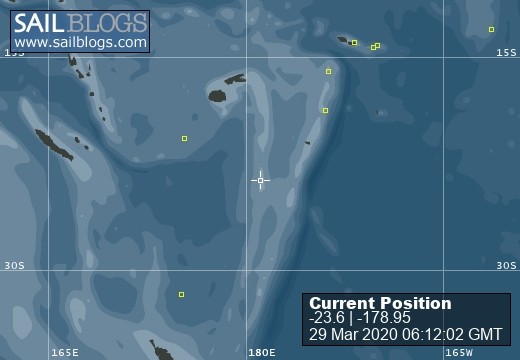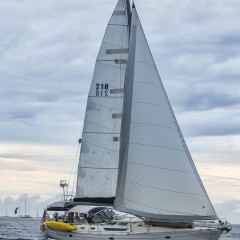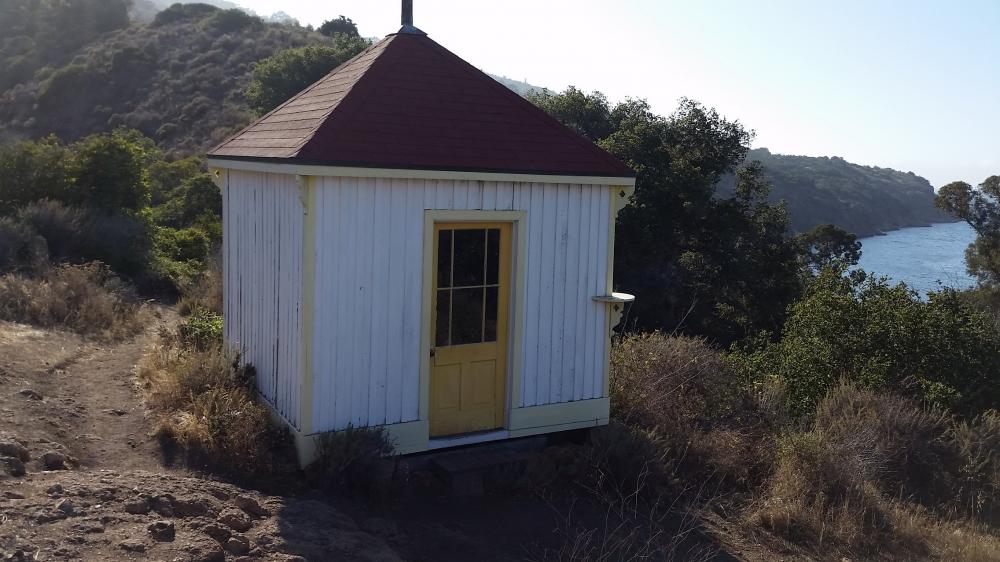

Pacific Adventures on WheytoGo
Our magical sailing experience has begun....
08 November 2019
31 October 2019
31 October 2019
31 October 2019
31 October 2019
31 October 2019
21 October 2019
18 October 2019
18 October 2019
18 October 2019
18 October 2019
18 October 2019
18 October 2019
18 October 2019 | Neiafu, Tonga
Household Chores to Paradise - Our Final Passage to New Zealand
08 November 2019
Ian Steele
6 November 2019 ,
Lat 31 22” S Long 175 05 “E Southern Pacific Ocean
Sailing southbound 240 miles due north of Opua, New Zealand
Household Chores in Paradise…our Final passage to NZ
We are now on day 5 of 7 of our 900-mile open ocean voyage from Minerva Reef to Opua, located in the Bay of Islands on the rugged northern coast of New Zealand, North Island. After surviving the first 3 days of pewter gray skies, ‘waring blender’ 2-3-meter seas angrily pounding our port bow (have you ever rode a roller coaster ride, or maybe a tilt-a-world for 3 days without stopping?) we are now motor sailing in nearly flat seas.
In spite of the sea state, there was some great text book sailing those first 4 days, skimming over the seas at 6-7 + knots in 15-20 knots of breeze with full (though heavily reefed) sails under the skillful guidance of Captain Ian who knows how to make Wheytogo give it her all! The weather changed yesterday, awakening us to deep blue cloudless skies with calm azure seas…and NO wind! It was an idyllic day at sea, even though we had to turn on the motors to gain forward motion through this frontal high. The water surface became glassier over the day, reminiscent of our May passage through the doldrums near the equator. No outward signs of life were visible, no boats, no sea life, no birds, as we navigated this very intimate encounter with these ancient waters.
As we passed through this calm deserted seascape a deeply spiritual feeling overtook us, a peaceful sense of connectedness with this powerful ocean, and a deep awareness of our very great fortune to have the privilege to experience it. As evening approached, a kaleidoscope of hypnotic pink-coral color seeped slowly across the western horizon, a little reward from Neptune for the intrepid ocean voyagers who brave the seas to bear witness.
A similar sea state has continued today, though with more cloud cover and still no wind, as we continue motoring on our southern voyage back to the “first world” lifestyle, last experienced in Hawaii in early May. We are anxious to arrive, see family, have long warm showers, have shore power and strong internet. And yet, there is a bittersweet sense of loss, as we leave behind these unique, one -of- a kind interactions with nature and peoples who belong to such a different world.
Now, from the sublime to the mundane…no matter how magical sailing through paradise can be, the pesky real-world problems still await us…smelly salty wet laundry, smelly fridge, creeping mold and mildew, crusted salt everywhere. Now motivated by our approaching land arrival, we are in a frenzy to do laundry, make more water (via the noisy de-salinator) for cleaning and drinking, empty the fridge, sort the mounting pile of garbage that we have to turn over to bio-security people in New Zealand. See...and you thought it was all just one magical holiday! We are cooking and eating our way through left -over provisions which will be confiscated by NZ authorities, who are quite strict about bringing in outside food, flora, fauna, germs and bugs. Two unopened bottles of honey are a definite no-no. If we ate 6 meals a day before our Friday AM arrival, we could not consume it all. Laundry is hanging to dry on a makeshift line on the back deck, making our lovely Wheytogo look like a sailing junk. Remaining wine is being consumed at an alarming rate, as Ian has decided to take one for the team! (just kidding!)
As we prepare, the skies are becoming grayer and the air cooler. We are definitely not in the tropics anymore.
Only 220 more miles and then LAND HO!! After so many weeks of dodging storms and carefully picking safe weather windows, we are relieved that we should make it there early on Friday, November 8 (only 7-10 days later than originally planned) before the next upcoming weather depression with 50 Knot winds is forecast to hit Opua on 9-10 November.
Thank you, mighty Neptune (and also David and Patricia at New Zealand Gulf Harbor Net, Rick Shema in Hawaii, our daily Tonga-Minerva Net SSB radio contacts, and all other weather gurus and fellow yachties who helped us thread that needle!) A special thanks to Tim and Anna on Pae’kaloa who hosted the daily Minerva Yacht Club radio sked on VHF at Minerva as well as the SSB net providing communication for all of us on passage to NZ.
As we approached land, we were greeted with heavy sea fog and grey skies, however familiar land marks from my years past deep-sea fishing experiences slowly came into view, Cape Brett [hole in the rock] to the south, the Nine Pins to the north and Urupukapuka Island. Adjusting our heading to our final way-point off Tapeka Point and the channel entrance, we motor sailed proudly into the Bay of Islands, what an adventure!...
As we approached Roberton Island on port, we glanced to our stern to see the Endeavor [Capt Cook’s replica sailing ship] supported by local Maori waka canoes moving into our wake and proceed to follow. How about that!
Wheytogo being the entry vessel to a small slice of NZ history as we round Tapeka Point, past Russell, Waitangi and Paihia to Opua.
Completing the Customs and Immigration formalities we tie up in our berth at the BOI marina…job safely well done.
Sharon and I commenced this amazing adventure of transiting the Pacific from Hawaii to NZ 6 months ago, visiting some magical Pacific islands and atolls, connecting with the different Polynesian peoples and cultures, establishing new friendships and sailing with many fellow cruisers, who like us, were living their dreams of adventure.
As we sign-off this phase of our exploration journey we thank you all for joining us on our Pacific discovery adventure. We remind ourselves and share, the inspiring words of Mark Twain:
“So, throw off the bowlines, sail away from the safe harbor and catch the trade winds in your sails”
Explore. Dream. Discover.
Lat 31 22” S Long 175 05 “E Southern Pacific Ocean
Sailing southbound 240 miles due north of Opua, New Zealand
Household Chores in Paradise…our Final passage to NZ
We are now on day 5 of 7 of our 900-mile open ocean voyage from Minerva Reef to Opua, located in the Bay of Islands on the rugged northern coast of New Zealand, North Island. After surviving the first 3 days of pewter gray skies, ‘waring blender’ 2-3-meter seas angrily pounding our port bow (have you ever rode a roller coaster ride, or maybe a tilt-a-world for 3 days without stopping?) we are now motor sailing in nearly flat seas.
In spite of the sea state, there was some great text book sailing those first 4 days, skimming over the seas at 6-7 + knots in 15-20 knots of breeze with full (though heavily reefed) sails under the skillful guidance of Captain Ian who knows how to make Wheytogo give it her all! The weather changed yesterday, awakening us to deep blue cloudless skies with calm azure seas…and NO wind! It was an idyllic day at sea, even though we had to turn on the motors to gain forward motion through this frontal high. The water surface became glassier over the day, reminiscent of our May passage through the doldrums near the equator. No outward signs of life were visible, no boats, no sea life, no birds, as we navigated this very intimate encounter with these ancient waters.
As we passed through this calm deserted seascape a deeply spiritual feeling overtook us, a peaceful sense of connectedness with this powerful ocean, and a deep awareness of our very great fortune to have the privilege to experience it. As evening approached, a kaleidoscope of hypnotic pink-coral color seeped slowly across the western horizon, a little reward from Neptune for the intrepid ocean voyagers who brave the seas to bear witness.
A similar sea state has continued today, though with more cloud cover and still no wind, as we continue motoring on our southern voyage back to the “first world” lifestyle, last experienced in Hawaii in early May. We are anxious to arrive, see family, have long warm showers, have shore power and strong internet. And yet, there is a bittersweet sense of loss, as we leave behind these unique, one -of- a kind interactions with nature and peoples who belong to such a different world.
Now, from the sublime to the mundane…no matter how magical sailing through paradise can be, the pesky real-world problems still await us…smelly salty wet laundry, smelly fridge, creeping mold and mildew, crusted salt everywhere. Now motivated by our approaching land arrival, we are in a frenzy to do laundry, make more water (via the noisy de-salinator) for cleaning and drinking, empty the fridge, sort the mounting pile of garbage that we have to turn over to bio-security people in New Zealand. See...and you thought it was all just one magical holiday! We are cooking and eating our way through left -over provisions which will be confiscated by NZ authorities, who are quite strict about bringing in outside food, flora, fauna, germs and bugs. Two unopened bottles of honey are a definite no-no. If we ate 6 meals a day before our Friday AM arrival, we could not consume it all. Laundry is hanging to dry on a makeshift line on the back deck, making our lovely Wheytogo look like a sailing junk. Remaining wine is being consumed at an alarming rate, as Ian has decided to take one for the team! (just kidding!)
As we prepare, the skies are becoming grayer and the air cooler. We are definitely not in the tropics anymore.
Only 220 more miles and then LAND HO!! After so many weeks of dodging storms and carefully picking safe weather windows, we are relieved that we should make it there early on Friday, November 8 (only 7-10 days later than originally planned) before the next upcoming weather depression with 50 Knot winds is forecast to hit Opua on 9-10 November.
Thank you, mighty Neptune (and also David and Patricia at New Zealand Gulf Harbor Net, Rick Shema in Hawaii, our daily Tonga-Minerva Net SSB radio contacts, and all other weather gurus and fellow yachties who helped us thread that needle!) A special thanks to Tim and Anna on Pae’kaloa who hosted the daily Minerva Yacht Club radio sked on VHF at Minerva as well as the SSB net providing communication for all of us on passage to NZ.
As we approached land, we were greeted with heavy sea fog and grey skies, however familiar land marks from my years past deep-sea fishing experiences slowly came into view, Cape Brett [hole in the rock] to the south, the Nine Pins to the north and Urupukapuka Island. Adjusting our heading to our final way-point off Tapeka Point and the channel entrance, we motor sailed proudly into the Bay of Islands, what an adventure!...
As we approached Roberton Island on port, we glanced to our stern to see the Endeavor [Capt Cook’s replica sailing ship] supported by local Maori waka canoes moving into our wake and proceed to follow. How about that!
Wheytogo being the entry vessel to a small slice of NZ history as we round Tapeka Point, past Russell, Waitangi and Paihia to Opua.
Completing the Customs and Immigration formalities we tie up in our berth at the BOI marina…job safely well done.
Sharon and I commenced this amazing adventure of transiting the Pacific from Hawaii to NZ 6 months ago, visiting some magical Pacific islands and atolls, connecting with the different Polynesian peoples and cultures, establishing new friendships and sailing with many fellow cruisers, who like us, were living their dreams of adventure.
As we sign-off this phase of our exploration journey we thank you all for joining us on our Pacific discovery adventure. We remind ourselves and share, the inspiring words of Mark Twain:
“So, throw off the bowlines, sail away from the safe harbor and catch the trade winds in your sails”
Explore. Dream. Discover.
Minerva Reef-Pics 5
31 October 2019
Ian Steele
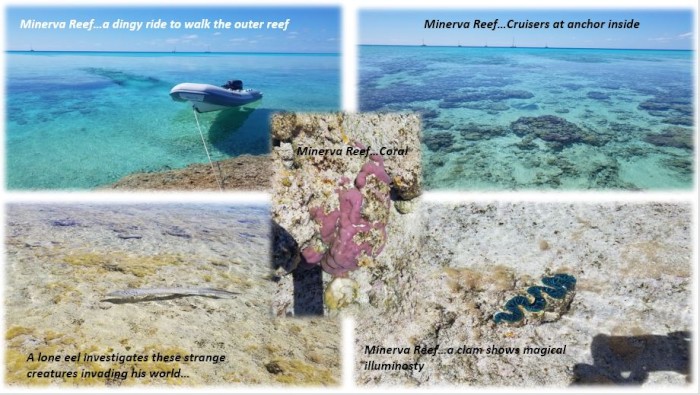
Minerva Reef Pics-4
31 October 2019
Ian Steele
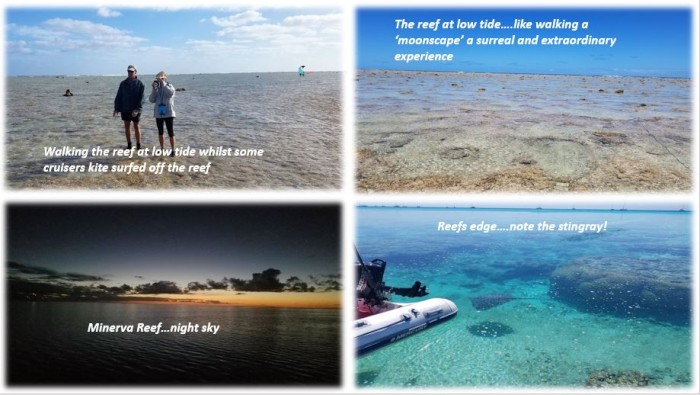
Minerva Reef Pics-3
31 October 2019
Ian Steele
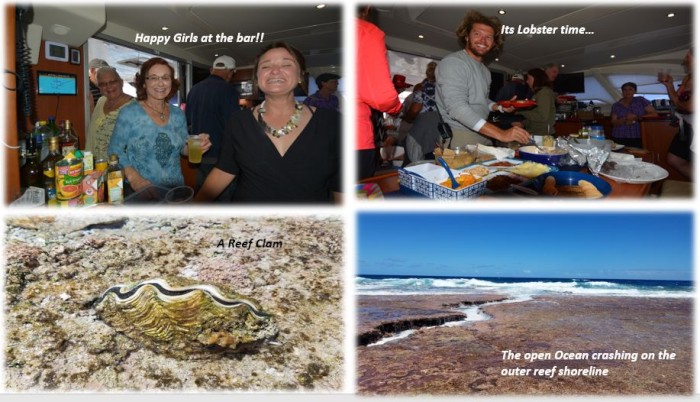
Minerva Reef Pics-2
31 October 2019
Ian Steele
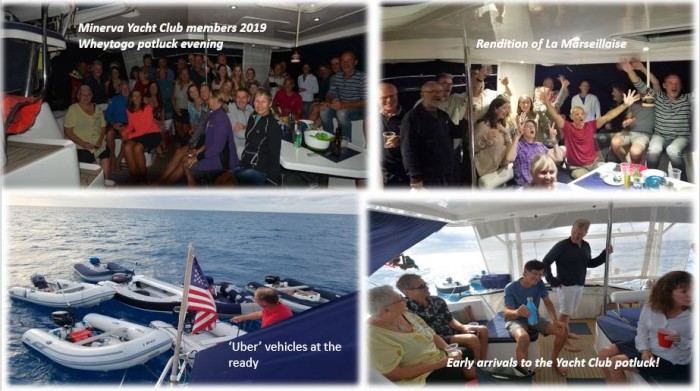
Birth of Minerva Yacht Club, North Minerva Reef
31 October 2019
Ian Steele
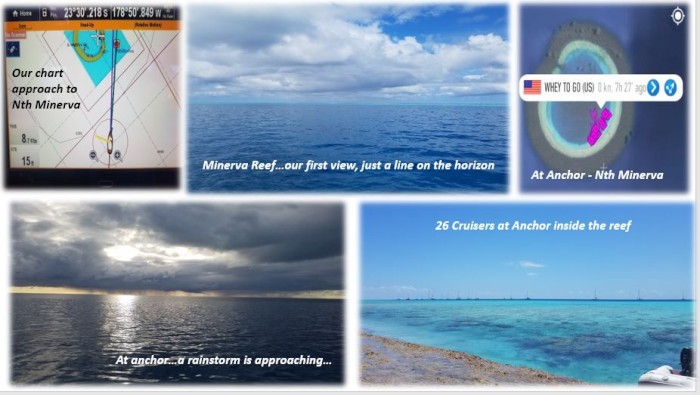
22-31 October 2019
Latitude 23.36 S Longitude 178.57 W South Pacific Ocean
BIRTH OF THE MINERVA REEF YACHT CLUB
Such a unique and fascinating place - a relatively small (3.5 miles across) and shallow coral -lined “aquarium” dropped into the middle of nowhere in a vast miles-deep ocean (the Tongan trench running east of here on the ocean floor reaches depths of greater than 5 miles), Minerva Reef is located in the Southern Pacific Ocean, hundreds of miles from any significant land mass.
When we first discussed possibly stopping in this isolated, seemingly barren atoll as a safe weather way-point en-route to New Zealand, I could not imagine being stuck here with nothing to do for 2 days, much less for 12 days, as it eventually turned out. To our great surprise, it turned out to be one of the most memorable highlights of our 6+ month voyage. The turquoise palettes, the pristine coral reefs, dramatic snorkeling in crystal clear waters with rich sea life (and sharks), the abundant (and so delicious) daily lobster catches and, yes, even the ever-present sharks added to the mystique. Walking on the rimming coral reefs at low tide was an ‘other-world’ experience which defies description, resembling an outer space moonwalk, a slippery beige porous coral surface with random rugged rock formations, dotted with colorful hard coral and teaming fish life darting in the shallow tidal pools washing over the reef. Barely visible except at very low tide, the completely encircling outer reef stretches several hundred yards in width as it creates a solid barrier between the inner lagoon and the crashing waves of the Pacific Ocean outside. And the beautiful silence…no cars, no TV, no traffic sounds, no airplanes, no garish news headlines or raucous political hoo-ha…. just wind and waves…this place seemed to cast a spell on all of us.
And yet, perhaps the most inspiring element of this unique environment was the sense of community and connection which developed between the fellow sailors also sequestered within the lagoon, awaiting a safe weather window for passage to New Zealand. At one point we counted 30 sailing yachts safely anchored there, all closely listening to daily weather reports from New Zealand Gulf Harbor Radio on SSB radio, then debating the relative merits of GO-NO GO on any given departure date, hoping to avoid the phenomenon of “analysis paralysis.” We cruisers set up our own VHF & SSB radio networks for daily communication at Minerva as well as for those arriving and those departing early. We continued the SSB net during passage to keep all connected daily as well as for safety.
In the interim we passed the time “dinghying” between the other boats, snorkeling just outside the reef to see gorgeous coral bommies and numerous reef sharks and territorial grey sharks (but thankfully never meeting the fabled tiger shark known to frequent the entrance pass to the lagoon…OMG!) My plan to give Wheytogo a little bottom cleaning was quickly squelched after others described circling sharks during their own cleaning attempts. Daily lobster diving became the norm, snorkeling or diving just outside the reef wall, reaching into to crevices and pulling out lobsters! Ian and I did not actually do this, but we were the lucky recipients of several unbelievably tasty lobsters given to us by thoughtful fellow sailors (think succulent lobster in drawn butter, or spicy Szechuan sauce…indescribable!)
One of the most fun experiences occurred when we invited our fellow cruisers to join us on Wheytogo for a potluck dinner…a meet and greet to pass the time in the lagoon. Little did we know that 20 or more dinghies would be parked behind our stern that evening (requiring valet Parking) and that 42 fellow sailors, anxious for social contact and a PARTY, would crowd on our tightly packed decks for a night of new friendships, commiseration, cooperation and sharing at this most improbable gathering. Men and women, young and old, even a few teens, gathered together in VERY CLOSE proximity to share incredible food and drink (at least 3 separate dishes of Minerva Reef lobster appeared, along with homemade pizza, lasagna, Mexican chicken, homemade tortillas, focaccia and honey bread to name just a few). Who would believe that that much abundance and variety of food could be created in this remote setting …leave it to the resourcefulness of sailors!
It was a multi-cultural event, blending people from Germany, Denmark, France, Italy, Sweden, New Zealand and of course, America. A melodious blending of accents was heard in the din as animated voices shared sea stories, fish stories, boat breakdown stories, mystical island stories while bonding with others who also knew firsthand and loved the experience of ocean cruising. Three very jolly Frenchmen from a newly-arrived sailboat provided much of the entertainment, which got even more boisterous as the French wine flowed in addition Tahitian rum in an Arizona tea container was passed around. Speaking in slightly broken English, they joked and laughed with total abandon, often to stand up, raise their glasses and loudly sing the French national anthem in the universal language of laughter, to the delight of all. Much later in the evening, they were very insistent that we follow them back to their boat where we should sing with them after they pulled out their musical instruments to play for us. Now exhausted, we politely declined. Getting all the guests back into their dinghies after dark in the now choppy sea was challenging, requiring some coordinated effort, and in a few cases, an ‘Uber’ ride back to their boat. The evening provided a fun catharsis, and later was dubbed the inaugural event of the newly-formed [by us] Minerva Yacht Club, with promises to hold the next gathering of the club after arrival in Opua. Stay tuned for pictures of too many people on a single catamaran. What amazing memories!
Vital communications of course to the ‘world’ outside Minerva( in addition to our standard on-board InReach, Satellite phone and Sat email to family & friends),was comprised of Sat email to our Weather & Routing consultant based in Hawaii [The Weatherguy] and our daily SSB [Single Side Band radio] link to Gulf Harbor Radio [GHR] New Zealand. Whilst we were in Tonga, we listened occasionally to Gulf Harbor Radio, however now in Minerva the daily GHR broadcast became crucial across the board for all 26+ of us boaties anchored waiting for our safe weather window to sail to NZ.
Background: Established in 2012, Gulf Harbor radio is a voluntary, privately run weather analysis and forecast routing broadcast service to the cruising community during May to mid-November. In particular cruisers planning to visit NZ from the Pacific, Fiji, Noumea, New Caledonia, Tonga etc. David Sapiane and Patricia Dallas have 15 years’ experience cruising these particular routes; accordingly, they have significant practical experience in addition to their respective professional skills and backgrounds. Both are scientists, David, from the USA with a BSc in Marine Science and Meteorology, Patricia, a Kiwi, has a Masters Science Degree with honors in chemistry. Both have also been Ham radio operators for many years.
I invite all of our readers to visit www.ghradio.co.nz to learn more about these amazing people who voluntarily provide such a valuable and critical service to all the cruising and fishing community in the South Pacific.
One ‘interesting’ story: whilst in Minerva we arranged to make a financial donation from us on Wheytogo to GHR, given the importance and critical service to us anchored in this remote part of the South Pacific and also recognizing and thanking them for their cruising guidance. The next morning, we received an email from Patricia, thanking us and saying “mmm Wheytogo? That suggests the Dairy Industry! Well I (Patricia) spent many years in the NZ Dairy industry based both in NZ and overseas,
Such a small world…Patricia and I worked with and knew personally, many of the same NZ Dairy, Anchor Products and Fonterra personnel.
Our GHR linkage and connection of course became personal and memorable and a close extension as our adventure to NZ continued.
One of our most unique Minerva experiences came most unexpectedly. Now anchored for nearly a week inside Minerva Reef – on Saturday 10:00am (the VHF is of course turned on 24/7), we suddenly hear the roar of a nearby turbojet airplane (what??) as we hear a voice calling out over the VHF radio “Wheytogo! Wheytogo! Wheytogo! this is the Royal New Zealand Air Force Orion now overhead at Minerva Reef…Can I speak with the Captain? “Yes Sir, the Captain speaking...”. Captain please confirm who is on board? Your target arrival date in Opua NZ? Etc., etc.…Following our direct communique, they proceeded to communicate directly with each boat [26] whilst circling low overhead for perhaps 40 minutes before signing off, wishing us all a safe passage to NZ and tilting their wing down in a fast-low-level final pass. An amazing feeling…we are being watched over by the very NZ authorities who would be at the front line should we require assistance during our continuing adventure.
Thank you, NZ Air Force!
Latitude 23.36 S Longitude 178.57 W South Pacific Ocean
BIRTH OF THE MINERVA REEF YACHT CLUB
Such a unique and fascinating place - a relatively small (3.5 miles across) and shallow coral -lined “aquarium” dropped into the middle of nowhere in a vast miles-deep ocean (the Tongan trench running east of here on the ocean floor reaches depths of greater than 5 miles), Minerva Reef is located in the Southern Pacific Ocean, hundreds of miles from any significant land mass.
When we first discussed possibly stopping in this isolated, seemingly barren atoll as a safe weather way-point en-route to New Zealand, I could not imagine being stuck here with nothing to do for 2 days, much less for 12 days, as it eventually turned out. To our great surprise, it turned out to be one of the most memorable highlights of our 6+ month voyage. The turquoise palettes, the pristine coral reefs, dramatic snorkeling in crystal clear waters with rich sea life (and sharks), the abundant (and so delicious) daily lobster catches and, yes, even the ever-present sharks added to the mystique. Walking on the rimming coral reefs at low tide was an ‘other-world’ experience which defies description, resembling an outer space moonwalk, a slippery beige porous coral surface with random rugged rock formations, dotted with colorful hard coral and teaming fish life darting in the shallow tidal pools washing over the reef. Barely visible except at very low tide, the completely encircling outer reef stretches several hundred yards in width as it creates a solid barrier between the inner lagoon and the crashing waves of the Pacific Ocean outside. And the beautiful silence…no cars, no TV, no traffic sounds, no airplanes, no garish news headlines or raucous political hoo-ha…. just wind and waves…this place seemed to cast a spell on all of us.
And yet, perhaps the most inspiring element of this unique environment was the sense of community and connection which developed between the fellow sailors also sequestered within the lagoon, awaiting a safe weather window for passage to New Zealand. At one point we counted 30 sailing yachts safely anchored there, all closely listening to daily weather reports from New Zealand Gulf Harbor Radio on SSB radio, then debating the relative merits of GO-NO GO on any given departure date, hoping to avoid the phenomenon of “analysis paralysis.” We cruisers set up our own VHF & SSB radio networks for daily communication at Minerva as well as for those arriving and those departing early. We continued the SSB net during passage to keep all connected daily as well as for safety.
In the interim we passed the time “dinghying” between the other boats, snorkeling just outside the reef to see gorgeous coral bommies and numerous reef sharks and territorial grey sharks (but thankfully never meeting the fabled tiger shark known to frequent the entrance pass to the lagoon…OMG!) My plan to give Wheytogo a little bottom cleaning was quickly squelched after others described circling sharks during their own cleaning attempts. Daily lobster diving became the norm, snorkeling or diving just outside the reef wall, reaching into to crevices and pulling out lobsters! Ian and I did not actually do this, but we were the lucky recipients of several unbelievably tasty lobsters given to us by thoughtful fellow sailors (think succulent lobster in drawn butter, or spicy Szechuan sauce…indescribable!)
One of the most fun experiences occurred when we invited our fellow cruisers to join us on Wheytogo for a potluck dinner…a meet and greet to pass the time in the lagoon. Little did we know that 20 or more dinghies would be parked behind our stern that evening (requiring valet Parking) and that 42 fellow sailors, anxious for social contact and a PARTY, would crowd on our tightly packed decks for a night of new friendships, commiseration, cooperation and sharing at this most improbable gathering. Men and women, young and old, even a few teens, gathered together in VERY CLOSE proximity to share incredible food and drink (at least 3 separate dishes of Minerva Reef lobster appeared, along with homemade pizza, lasagna, Mexican chicken, homemade tortillas, focaccia and honey bread to name just a few). Who would believe that that much abundance and variety of food could be created in this remote setting …leave it to the resourcefulness of sailors!
It was a multi-cultural event, blending people from Germany, Denmark, France, Italy, Sweden, New Zealand and of course, America. A melodious blending of accents was heard in the din as animated voices shared sea stories, fish stories, boat breakdown stories, mystical island stories while bonding with others who also knew firsthand and loved the experience of ocean cruising. Three very jolly Frenchmen from a newly-arrived sailboat provided much of the entertainment, which got even more boisterous as the French wine flowed in addition Tahitian rum in an Arizona tea container was passed around. Speaking in slightly broken English, they joked and laughed with total abandon, often to stand up, raise their glasses and loudly sing the French national anthem in the universal language of laughter, to the delight of all. Much later in the evening, they were very insistent that we follow them back to their boat where we should sing with them after they pulled out their musical instruments to play for us. Now exhausted, we politely declined. Getting all the guests back into their dinghies after dark in the now choppy sea was challenging, requiring some coordinated effort, and in a few cases, an ‘Uber’ ride back to their boat. The evening provided a fun catharsis, and later was dubbed the inaugural event of the newly-formed [by us] Minerva Yacht Club, with promises to hold the next gathering of the club after arrival in Opua. Stay tuned for pictures of too many people on a single catamaran. What amazing memories!
Vital communications of course to the ‘world’ outside Minerva( in addition to our standard on-board InReach, Satellite phone and Sat email to family & friends),was comprised of Sat email to our Weather & Routing consultant based in Hawaii [The Weatherguy] and our daily SSB [Single Side Band radio] link to Gulf Harbor Radio [GHR] New Zealand. Whilst we were in Tonga, we listened occasionally to Gulf Harbor Radio, however now in Minerva the daily GHR broadcast became crucial across the board for all 26+ of us boaties anchored waiting for our safe weather window to sail to NZ.
Background: Established in 2012, Gulf Harbor radio is a voluntary, privately run weather analysis and forecast routing broadcast service to the cruising community during May to mid-November. In particular cruisers planning to visit NZ from the Pacific, Fiji, Noumea, New Caledonia, Tonga etc. David Sapiane and Patricia Dallas have 15 years’ experience cruising these particular routes; accordingly, they have significant practical experience in addition to their respective professional skills and backgrounds. Both are scientists, David, from the USA with a BSc in Marine Science and Meteorology, Patricia, a Kiwi, has a Masters Science Degree with honors in chemistry. Both have also been Ham radio operators for many years.
I invite all of our readers to visit www.ghradio.co.nz to learn more about these amazing people who voluntarily provide such a valuable and critical service to all the cruising and fishing community in the South Pacific.
One ‘interesting’ story: whilst in Minerva we arranged to make a financial donation from us on Wheytogo to GHR, given the importance and critical service to us anchored in this remote part of the South Pacific and also recognizing and thanking them for their cruising guidance. The next morning, we received an email from Patricia, thanking us and saying “mmm Wheytogo? That suggests the Dairy Industry! Well I (Patricia) spent many years in the NZ Dairy industry based both in NZ and overseas,
Such a small world…Patricia and I worked with and knew personally, many of the same NZ Dairy, Anchor Products and Fonterra personnel.
Our GHR linkage and connection of course became personal and memorable and a close extension as our adventure to NZ continued.
One of our most unique Minerva experiences came most unexpectedly. Now anchored for nearly a week inside Minerva Reef – on Saturday 10:00am (the VHF is of course turned on 24/7), we suddenly hear the roar of a nearby turbojet airplane (what??) as we hear a voice calling out over the VHF radio “Wheytogo! Wheytogo! Wheytogo! this is the Royal New Zealand Air Force Orion now overhead at Minerva Reef…Can I speak with the Captain? “Yes Sir, the Captain speaking...”. Captain please confirm who is on board? Your target arrival date in Opua NZ? Etc., etc.…Following our direct communique, they proceeded to communicate directly with each boat [26] whilst circling low overhead for perhaps 40 minutes before signing off, wishing us all a safe passage to NZ and tilting their wing down in a fast-low-level final pass. An amazing feeling…we are being watched over by the very NZ authorities who would be at the front line should we require assistance during our continuing adventure.
Thank you, NZ Air Force!
Farewell Vava'u...New Zealand we are headed your way..
21 October 2019
Ian Steele
18- 21 October 2019 Pacific Ocean somewhere south of Tonga
Farewell Vava’u …New Zealand – we are headed your way at last!
Lat 20 36’800S Lon 175 19’000W
After more than 2 ½ months of cruising in Vava’u, Kingdom of Tonga, Ian and I ( aboard our trusty catamaran WheytoGo) have finally departed for the 1350 nautical mile trip south to New Zealand, birth home of Ian AND the World Champion rugby team, the All Blacks, who are currently in Japan where the World Rugby championship quarter finals are now underway. We have been waiting (rather impatiently) for the past two weeks to identify a safe “weather window” on this prolonged journey over what could arguably be one of the more difficult passage routes in the world due to the weather patterns and big storms so common along the way. Thus, the careful research and timing of the weather patterns is essential, in order to avoid being caught in one of these dangerous storms at sea while you are hundreds of miles away from any land mass.
We left Neiafu Harbor after clearing customs at midday Friday and headed out to sea in cloudy and windy conditions which our computer weather models had predicted would improve in several hours, but that was not to be. We would head south along the western edge of the Tongan islands, eventually passing the Haapai group, then passing 50 miles east of the volcanic island which had been spouting steam and threatening eruption 2 days prior, and then finally passing Tongatapu, the southernmost group of the long island chain, en route to Minerva Reef, an atoll in the middle of the Pacific some 400 miles south of Vava’u.
Two hours out to sea the weather worsened considerably and the winds kicked up to 35+ knots with 7-8-foot seas pounding us on our port beam. This pattern continued over the next 18 hours, as I clung to my barf bucket, sleeping on the back deck while Ian manned the helm. Radio communication with other boats also heading to Minerva Reef, the only anchor option on the 1300-mile route to NZ, indicated similarly uncomfortable conditions. The following day dawned brighter, bringing forth hope of a better sailing day. This proved to be true with more manageable winds, steadily improving seas and clear radar…UNTIL … at 2130 that very calm, dark evening when a single squall suddenly popped up on radar, as winds trickled down to 4-6 knots, with only the Genoa out. The squall line moved closer, but the winds remained very low, then, very suddenly, the winds jumped to 16k, 24, 28, 32 knots in less than a minute, and the seas went crazy! The winds became sustained at 36+ knots and the boat seemed to strain in every direction as we struggled to get the Genoa in, as periodic gusts in the 45knot range appeared (please God, don’t get to 50K) and torrential rains pummeled the boat, saturating the back deck and even the helm. This storm seemed to hover over us on radar without movement for over 45 minutes (felt like 2 hours!) as the boat tried to spin around like a top. Ian did an amazing job of manually helming as he strained to keep control of the boat in the insane winds. Without question, the most unexpected and frightening sailing weather experience I have ever had, and pray that I never see again.
Tomorrow WILL BE a better day!
The following day dawned bright and clear and we had the best sailing conditions imaginable, as we skimmed over the calmer waters with 18-20K winds on our aft quarter, 2 reefs in the main and a full Genoa, maintaining 7-8 knots in perfect conditions-what a difference a day makes!
On Monday, 21 October, 74 hours after leaving Vava’u, we finally arrived at North Minerva Reef, a large atoll appearing out of nowhere in the middle of miles and miles of uninterrupted ocean. The tall masts of the sailboats anchored inside the lagoon became visible first, then the Pacific waves crashing over the barely visible reefs of the 3.5-mile-wide lagoon became apparent.
This atoll and its sister atoll South Minerva reef have wreaked havoc with sailing vessels in this region of the pacific for hundreds of years, resulting in numerous ships who sank after an encounter with the hidden coral reefs. [Originally named after the whale-ship Minerva was wrecked on the reef in 1829]. Now well-charted in this modern navigation era, these reefs have become a popular anchoring spot for cruising vessels seeking safe harbor or anchorage on passages from Tonga to NZ & vice versa.
We arrived around 3pm to a beautiful sunny day, entered the reef through the narrow entrance to be greeted with calm flat waters inside the lagoon and anchored in 50 ft of clear turquoise water. While anxious to jump in for a dip, we were wary of the reports of many large sharks in the lagoon…just glad to be anchored and looking forward to a good night of sleep uninterrupted by the night watch. Plenty of time to explore the lagoon tomorrow.
Farewell Vava’u …New Zealand – we are headed your way at last!
Lat 20 36’800S Lon 175 19’000W
After more than 2 ½ months of cruising in Vava’u, Kingdom of Tonga, Ian and I ( aboard our trusty catamaran WheytoGo) have finally departed for the 1350 nautical mile trip south to New Zealand, birth home of Ian AND the World Champion rugby team, the All Blacks, who are currently in Japan where the World Rugby championship quarter finals are now underway. We have been waiting (rather impatiently) for the past two weeks to identify a safe “weather window” on this prolonged journey over what could arguably be one of the more difficult passage routes in the world due to the weather patterns and big storms so common along the way. Thus, the careful research and timing of the weather patterns is essential, in order to avoid being caught in one of these dangerous storms at sea while you are hundreds of miles away from any land mass.
We left Neiafu Harbor after clearing customs at midday Friday and headed out to sea in cloudy and windy conditions which our computer weather models had predicted would improve in several hours, but that was not to be. We would head south along the western edge of the Tongan islands, eventually passing the Haapai group, then passing 50 miles east of the volcanic island which had been spouting steam and threatening eruption 2 days prior, and then finally passing Tongatapu, the southernmost group of the long island chain, en route to Minerva Reef, an atoll in the middle of the Pacific some 400 miles south of Vava’u.
Two hours out to sea the weather worsened considerably and the winds kicked up to 35+ knots with 7-8-foot seas pounding us on our port beam. This pattern continued over the next 18 hours, as I clung to my barf bucket, sleeping on the back deck while Ian manned the helm. Radio communication with other boats also heading to Minerva Reef, the only anchor option on the 1300-mile route to NZ, indicated similarly uncomfortable conditions. The following day dawned brighter, bringing forth hope of a better sailing day. This proved to be true with more manageable winds, steadily improving seas and clear radar…UNTIL … at 2130 that very calm, dark evening when a single squall suddenly popped up on radar, as winds trickled down to 4-6 knots, with only the Genoa out. The squall line moved closer, but the winds remained very low, then, very suddenly, the winds jumped to 16k, 24, 28, 32 knots in less than a minute, and the seas went crazy! The winds became sustained at 36+ knots and the boat seemed to strain in every direction as we struggled to get the Genoa in, as periodic gusts in the 45knot range appeared (please God, don’t get to 50K) and torrential rains pummeled the boat, saturating the back deck and even the helm. This storm seemed to hover over us on radar without movement for over 45 minutes (felt like 2 hours!) as the boat tried to spin around like a top. Ian did an amazing job of manually helming as he strained to keep control of the boat in the insane winds. Without question, the most unexpected and frightening sailing weather experience I have ever had, and pray that I never see again.
Tomorrow WILL BE a better day!
The following day dawned bright and clear and we had the best sailing conditions imaginable, as we skimmed over the calmer waters with 18-20K winds on our aft quarter, 2 reefs in the main and a full Genoa, maintaining 7-8 knots in perfect conditions-what a difference a day makes!
On Monday, 21 October, 74 hours after leaving Vava’u, we finally arrived at North Minerva Reef, a large atoll appearing out of nowhere in the middle of miles and miles of uninterrupted ocean. The tall masts of the sailboats anchored inside the lagoon became visible first, then the Pacific waves crashing over the barely visible reefs of the 3.5-mile-wide lagoon became apparent.
This atoll and its sister atoll South Minerva reef have wreaked havoc with sailing vessels in this region of the pacific for hundreds of years, resulting in numerous ships who sank after an encounter with the hidden coral reefs. [Originally named after the whale-ship Minerva was wrecked on the reef in 1829]. Now well-charted in this modern navigation era, these reefs have become a popular anchoring spot for cruising vessels seeking safe harbor or anchorage on passages from Tonga to NZ & vice versa.
We arrived around 3pm to a beautiful sunny day, entered the reef through the narrow entrance to be greeted with calm flat waters inside the lagoon and anchored in 50 ft of clear turquoise water. While anxious to jump in for a dip, we were wary of the reports of many large sharks in the lagoon…just glad to be anchored and looking forward to a good night of sleep uninterrupted by the night watch. Plenty of time to explore the lagoon tomorrow.
Vava'u, Kingdom of Tonga-Pics 7
18 October 2019
Ian Steele
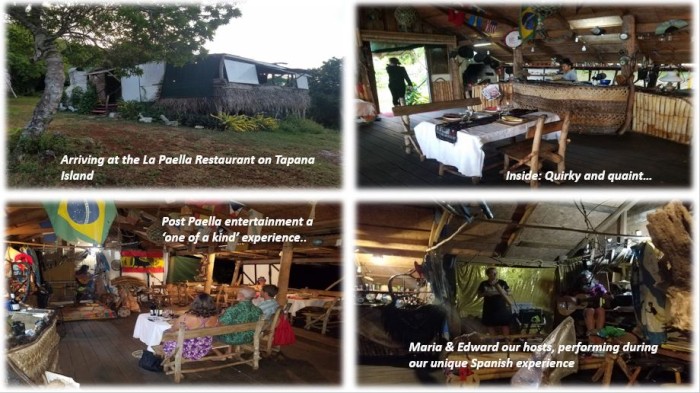
Vava'u, Kingdom of Tonga-Pics 6
18 October 2019
Ian Steele
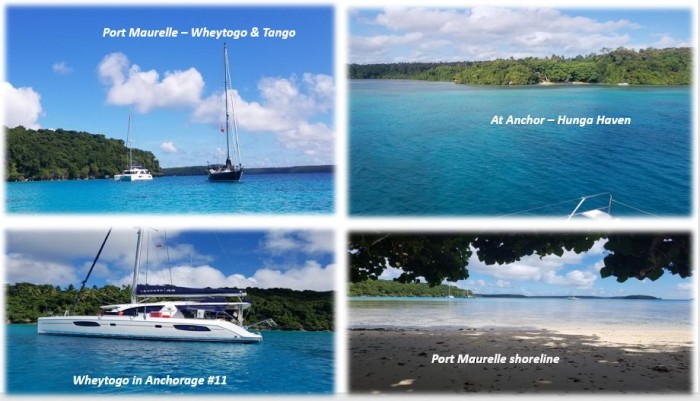
Vava'u, Kingdom of Tonga- Pics 5
18 October 2019
Ian Steele
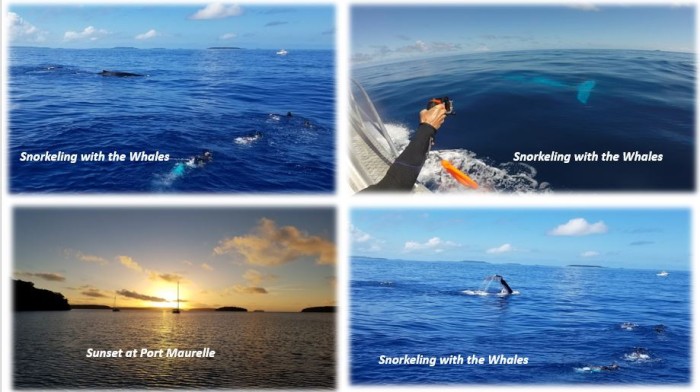
Vava'u, Kingdom of Tonga- Pics 4
18 October 2019
Ian Steele
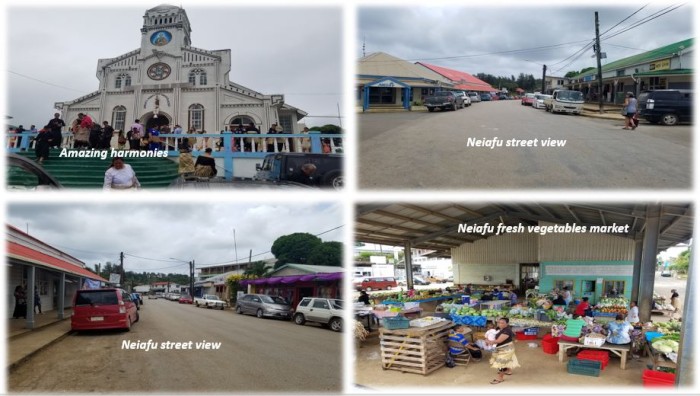
Vava'u, Kingdom of Tonga - Pics 3
18 October 2019
Ian Steele
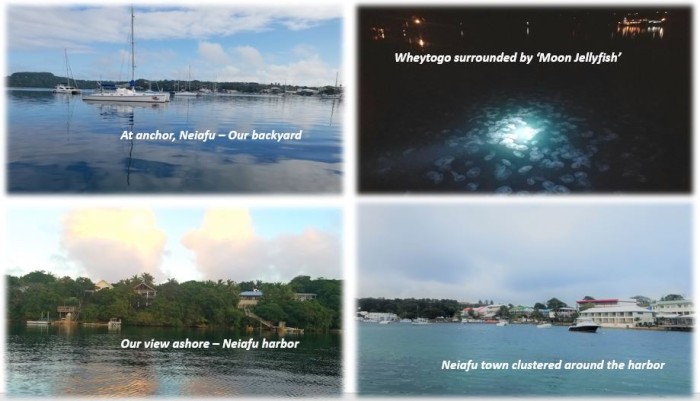
Vava'u, Kingdom of Tonga- Pics 2
18 October 2019
Ian Steele
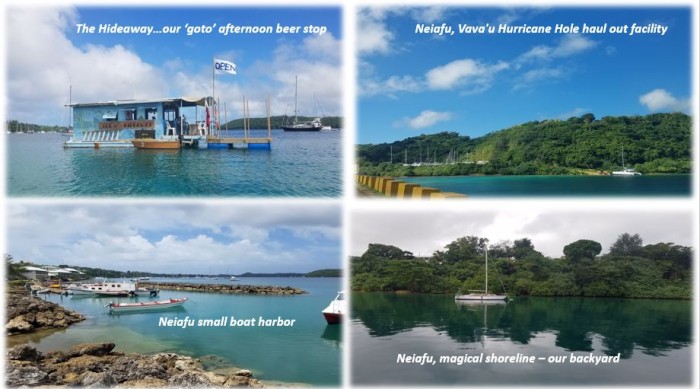
Vava'u, The Kingdom of Tonga
18 October 2019 | Neiafu, Tonga
Ian Steele
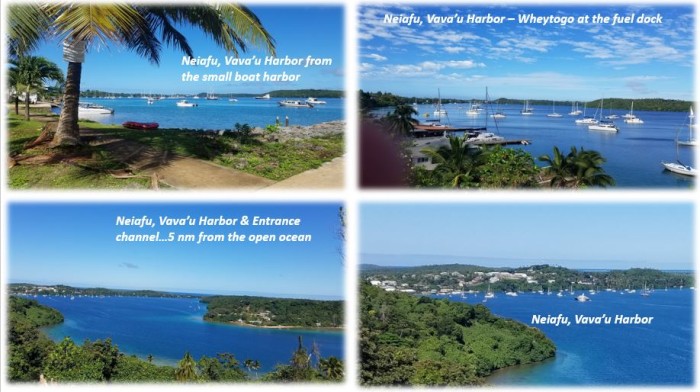
August -October 2019
Vava'u, Kingdom of Tonga
Latitude 18.38 S Longitude 174.01 W Southern Pacific Ocean
It's been a magical 2.5 months in this relatively unknown, very isolated and rural chain of limestone and volcanic Polynesian islands hidden away in the southern Pacific Ocean, some 1200 nautical miles northeast of New Zealand, 330 n. miles south of Western Samoa and 480 n. miles east of Fiji. It is made up 160+ islands divided into clusters of 4 main groups, the northernmost Nias, then the Vava'u group where we are now, followed by the Haapai group to the south and finally Tongatapu group at the southernmost end of this long chain stretching over 330 n miles.
Having spent 2 delightful weeks in Niuatoputapu, the northernmost group and our initial entry point into the kingdom of Tonga (see earlier blog) we next sailed overnight to the Vava'u group, a sailing paradise best known by cruisers from all over the world as a unique location to swim with large groups of migrating humpback whales on their annual northern route from Antarctica. Also, this island group is an excellent offshore fishing, diving and sailing destination with hundreds of picturesque islands and bays with well protected harbors. Of further significance to cruisers, is that Vava'u is a recognized 'hurricane hole' where boats can be stored on land, well protected, during the central Pacific hurricane season (November to May).
We arrived here on July 31 after an overnight sail from Niuatoputapu and wound our way through the clusters of small green cliff-faced islands into the inner harbor below the tiny town of Neiafu, (having only 2 main streets with a handful of small un-named storefronts) perched on a cliff high above the protected harbor, which was dotted with over 60 visiting sailboats and power yachts from all over the world. We located a free mooring ball and were quickly attached to what would become our new harbor home for the next 12-14 weeks. After clearing customs with surprising ease on the water front, we went exploring in our dinghy and soon found one of our favorite haunts, a floating bar called the Hideaway, operated by a friendly Canadian expat known as "Bear" who served amazing fish and chips and some of the best margaritas I have ever tasted (hand -made with fresh-picked local "kola' limes), pretty high praise from a Mexican-margarita loving Texan)! We soon recognized a purple boat flag hanging on the wall of the open-air dining area as being from UNO MAS, a sailing catamaran belonging to our sailing friends we had met while previously in Samoa. Bear, who speaks almost as fast and loud as the late Robin Williams (with jokes almost as raunchy) and refers on morning Vava'u Cruisers VHF radio net to his floating barge as the only floating and 360-degree revolving restaurant in Vava'u with its own floating pool ( a blowup water raft), told us that they had becomes regulars there during their prior visit. Well, that must mean that we are all almost family, and soon we were loaning him power tools from our boat to help add additional dock seating to his floating restaurant (never mind that it blew up and we wound trying to import another drill on the ferry, and ultimately brought in another from the US, but that's a story for another day).
While waiting for the other 2 sailboats we had sailed down with to arrive in the harbor, our first arrival tasks were dingy into town to pick up our Blue Sky sim cards and check out the provisions available here, having been weeks without any dairy products, fresh milk, cheese or fresh eggs or meat (or beer). We learned that while there was a lot more available here compared to Niuatoputapu, particularly when the weekly ferry arrived every Wednesday, it was still very limited and quite expensive, nevertheless, our options had expanded significantly! Not surprisingly the small corner supermarkets are all Chinese operated and by shopping at each, we were able to replenish essentials. Over time we identified our favorite few for specific needs, bread, Kiwi wines, Rum etc. For meats we relied mostly on the small Falaleu Deli owned and operated by Char (Bear's wife from the Hideaway). Imported meats, chicken, homemade patties, sausages etc. For fresh vegetables Neiafu has a daily fresh food market where many local villages and home growers display there produce and whilst some of our 'Western staples' were missing the essentials were fresh and available.
Next, we headed straight to Beluga diving to book our tickets for our much-anticipated swim with the whales, learning that they were completely booked for many days, but had 2 spots on a Saturday a few weeks later, which we immediately booked.
Our mooring was equally close to another cruiser- favorite meeting spot, Mangoes Bar & Grill, complete with dingy landing, live sports on TV and great all-day breakfasts as well as a standard menu. In addition to the Hideaway, this was our 'go to' stop over to connect with other cruisers, watch NZ rugby or simply to go ashore for a quiet beer and wine.
In Tonga, like all other island communities we visited during or adventure, Sunday AM was dedicated to going to church, with all shops either closed for the morning or all day. We, along with many other cruisers attended to both link with the local culture and to listed to the amazing church choir, magical harmonies across the assembled congregations...a spectacular and inspiring experience.
One of the best experiences related to sailing is the opportunity to meet and befriend people from many different parts of the world, as well as fellow Americans, most of whom are all very far from home. One such chance encounter led to a close friendship and connection with an American couple from California, John and Janet on their gorgeous monohull sailing yacht, Tango. Starting with a casual happy hour aboard Tango, we soon found ourselves sharing many meals, dinghy trips to town and sailing trips to surrounding islands for swimming, diving and snorkeling on overnight anchorages.
One of our favorite anchorages was Port Maurelle, a clear shallow bay about an hour sail from Neiafu harbor, where you could swim and snorkel in crystal clear water 40-60 feet deep. We spent several nights there, anchoring in the quiet peaceful bay, among the picturesque islets, with long walks on the deserted beach nearby, sharing meals on board each other's boats. During this time my dear friend Carol from Hawaii came to visit us in Vava'u and we spent happy hours diving and snorkeling with her as well as John and Janet, exploring a number of these pristine sites, including Swallow's cave, Japanese Gardens and most importantly, swimming with the humpback whales in the open ocean, just outside the Vava'u island group.
In early October, our friends from New Zealand, Mary and Graham, flew in to join us on WheytoGo in preparation for sailing back to New Zealand together and sharing "crew" duties on this our final long and potentially difficult passage to Opua, NZ. They came in early to spend time diving and exploring the region before our actual departure, targeted for mid-October. One of the most memorable outings (other than a few great dive trips with a local Kiwi dive outfit) took place at Anchorage #11, a two-hour sail from Neiafu Harbor, winding through the cluster of small islands to reach yet another gorgeous and remote anchoring site. Our friends on Tango also sailed to that anchorage, with plans for us to all meet and enjoy some snorkeling, swimming and playing in this special little bay. We heard tale of a quaint local restaurant "La Paella", located on the cliff of Tapana Island across from our secluded bay, which is run by an older couple from Spain who had sailed to Tonga many years ago, decided to stay and opened this restaurant which could only be reached by boat and open only by prior appointment. John and Janet had secured reservation for us six, but sadly, upon arriving at the anchorage they had a mechanical problem with their anchor which prevented them from safely anchoring and they had to turn back and return to Neiafu Harbor, to our great disappointment. Getting to the restaurant was a bit challenging: it required taking the dinghy across the bay to this tiny isolated islet, landing on the beach in choppy surf, climbing out of the dinghy into the wet surf and sand in our dinner dresses, tying the dinghy to a tree and climbing up some rugged rudimentary steps to the top of the hill where this decrepit, leaning and deserted-looking building with open air windows and thatched walls was located. "Could this be it?" we wondered.
Approaching a door which was accessed by steps surrounded by massive vertebral whale bones, we entered a rustic, dusty, yet charming room emanating with amazing aromas and Spanish music in the background. We were seated around an old table with a crisp white tablecloth set with old, cracked but elegant dinnerware in a Spanish motif along with ornate antique silverware. Soon we were served Spanish wine and lovely individual plates of tapas whose presentation would rival that of any 4-star restaurant. The final dish was a large platter of classic Spanish paella, laden with multiple saffron-coated morsels of fresh seafood. After dinner, Maria and Edward, the owners, moved over to a makeshift stage, where Edward sat on a stool and strummed his acoustical guitar while singing songs in gravelly Spanish, his long, kinky gray hair and beard flowing in the breeze. Another couple there, celebrating a birthday, danced on the wood floor as he sang a crusty version of "Happy Birthday to You" in broken English, stopping to swig a beer provided by his wife, Maria between sets. It was an enchanted and very unexpected evening of unique food and entertainment, which Ian, myself, Mary and Graham, smiling in amazement and frequently bemoaning the fact that John and Janet could not be with us to see this amazing spectacle. We vowed that we would bring them back here in the near future, however, it was not to be.
As recurring weather delays repeatedly postponed our planned departure, Mary and Graham eventually were forced to fly back to New Zealand and miss the passage. John and Janet were stuck in Vava'u as they awaited overseas shipment of equipment to repair their anchor issues. After much agonizing over best departure time in the face of the coming cyclone season, (our boat insurance required that we be out of the cyclone area to insure continued coverage) Ian and I set out to make the long journey to New Zealand alone, departing on Friday, October 18, a rainy, windy and depressing day with choppy seas which pounded WheytoGo against the harbor docks as we completed the slow customs and immigration process to check out of the country of Tonga. We said our goodbyes to Mary and Graham, Janet and John, and other yachties we had befriended over the prior 3 months, and headed south in the rain and wind, hoping the weather would improve in 2-3 hours as the forecasts suggested. That, also, was not to be. The next 24 hours would bring the highest winds and most seasickness I had experienced since leaving Hawaii in early May.
Vava'u, Kingdom of Tonga
Latitude 18.38 S Longitude 174.01 W Southern Pacific Ocean
It's been a magical 2.5 months in this relatively unknown, very isolated and rural chain of limestone and volcanic Polynesian islands hidden away in the southern Pacific Ocean, some 1200 nautical miles northeast of New Zealand, 330 n. miles south of Western Samoa and 480 n. miles east of Fiji. It is made up 160+ islands divided into clusters of 4 main groups, the northernmost Nias, then the Vava'u group where we are now, followed by the Haapai group to the south and finally Tongatapu group at the southernmost end of this long chain stretching over 330 n miles.
Having spent 2 delightful weeks in Niuatoputapu, the northernmost group and our initial entry point into the kingdom of Tonga (see earlier blog) we next sailed overnight to the Vava'u group, a sailing paradise best known by cruisers from all over the world as a unique location to swim with large groups of migrating humpback whales on their annual northern route from Antarctica. Also, this island group is an excellent offshore fishing, diving and sailing destination with hundreds of picturesque islands and bays with well protected harbors. Of further significance to cruisers, is that Vava'u is a recognized 'hurricane hole' where boats can be stored on land, well protected, during the central Pacific hurricane season (November to May).
We arrived here on July 31 after an overnight sail from Niuatoputapu and wound our way through the clusters of small green cliff-faced islands into the inner harbor below the tiny town of Neiafu, (having only 2 main streets with a handful of small un-named storefronts) perched on a cliff high above the protected harbor, which was dotted with over 60 visiting sailboats and power yachts from all over the world. We located a free mooring ball and were quickly attached to what would become our new harbor home for the next 12-14 weeks. After clearing customs with surprising ease on the water front, we went exploring in our dinghy and soon found one of our favorite haunts, a floating bar called the Hideaway, operated by a friendly Canadian expat known as "Bear" who served amazing fish and chips and some of the best margaritas I have ever tasted (hand -made with fresh-picked local "kola' limes), pretty high praise from a Mexican-margarita loving Texan)! We soon recognized a purple boat flag hanging on the wall of the open-air dining area as being from UNO MAS, a sailing catamaran belonging to our sailing friends we had met while previously in Samoa. Bear, who speaks almost as fast and loud as the late Robin Williams (with jokes almost as raunchy) and refers on morning Vava'u Cruisers VHF radio net to his floating barge as the only floating and 360-degree revolving restaurant in Vava'u with its own floating pool ( a blowup water raft), told us that they had becomes regulars there during their prior visit. Well, that must mean that we are all almost family, and soon we were loaning him power tools from our boat to help add additional dock seating to his floating restaurant (never mind that it blew up and we wound trying to import another drill on the ferry, and ultimately brought in another from the US, but that's a story for another day).
While waiting for the other 2 sailboats we had sailed down with to arrive in the harbor, our first arrival tasks were dingy into town to pick up our Blue Sky sim cards and check out the provisions available here, having been weeks without any dairy products, fresh milk, cheese or fresh eggs or meat (or beer). We learned that while there was a lot more available here compared to Niuatoputapu, particularly when the weekly ferry arrived every Wednesday, it was still very limited and quite expensive, nevertheless, our options had expanded significantly! Not surprisingly the small corner supermarkets are all Chinese operated and by shopping at each, we were able to replenish essentials. Over time we identified our favorite few for specific needs, bread, Kiwi wines, Rum etc. For meats we relied mostly on the small Falaleu Deli owned and operated by Char (Bear's wife from the Hideaway). Imported meats, chicken, homemade patties, sausages etc. For fresh vegetables Neiafu has a daily fresh food market where many local villages and home growers display there produce and whilst some of our 'Western staples' were missing the essentials were fresh and available.
Next, we headed straight to Beluga diving to book our tickets for our much-anticipated swim with the whales, learning that they were completely booked for many days, but had 2 spots on a Saturday a few weeks later, which we immediately booked.
Our mooring was equally close to another cruiser- favorite meeting spot, Mangoes Bar & Grill, complete with dingy landing, live sports on TV and great all-day breakfasts as well as a standard menu. In addition to the Hideaway, this was our 'go to' stop over to connect with other cruisers, watch NZ rugby or simply to go ashore for a quiet beer and wine.
In Tonga, like all other island communities we visited during or adventure, Sunday AM was dedicated to going to church, with all shops either closed for the morning or all day. We, along with many other cruisers attended to both link with the local culture and to listed to the amazing church choir, magical harmonies across the assembled congregations...a spectacular and inspiring experience.
One of the best experiences related to sailing is the opportunity to meet and befriend people from many different parts of the world, as well as fellow Americans, most of whom are all very far from home. One such chance encounter led to a close friendship and connection with an American couple from California, John and Janet on their gorgeous monohull sailing yacht, Tango. Starting with a casual happy hour aboard Tango, we soon found ourselves sharing many meals, dinghy trips to town and sailing trips to surrounding islands for swimming, diving and snorkeling on overnight anchorages.
One of our favorite anchorages was Port Maurelle, a clear shallow bay about an hour sail from Neiafu harbor, where you could swim and snorkel in crystal clear water 40-60 feet deep. We spent several nights there, anchoring in the quiet peaceful bay, among the picturesque islets, with long walks on the deserted beach nearby, sharing meals on board each other's boats. During this time my dear friend Carol from Hawaii came to visit us in Vava'u and we spent happy hours diving and snorkeling with her as well as John and Janet, exploring a number of these pristine sites, including Swallow's cave, Japanese Gardens and most importantly, swimming with the humpback whales in the open ocean, just outside the Vava'u island group.
In early October, our friends from New Zealand, Mary and Graham, flew in to join us on WheytoGo in preparation for sailing back to New Zealand together and sharing "crew" duties on this our final long and potentially difficult passage to Opua, NZ. They came in early to spend time diving and exploring the region before our actual departure, targeted for mid-October. One of the most memorable outings (other than a few great dive trips with a local Kiwi dive outfit) took place at Anchorage #11, a two-hour sail from Neiafu Harbor, winding through the cluster of small islands to reach yet another gorgeous and remote anchoring site. Our friends on Tango also sailed to that anchorage, with plans for us to all meet and enjoy some snorkeling, swimming and playing in this special little bay. We heard tale of a quaint local restaurant "La Paella", located on the cliff of Tapana Island across from our secluded bay, which is run by an older couple from Spain who had sailed to Tonga many years ago, decided to stay and opened this restaurant which could only be reached by boat and open only by prior appointment. John and Janet had secured reservation for us six, but sadly, upon arriving at the anchorage they had a mechanical problem with their anchor which prevented them from safely anchoring and they had to turn back and return to Neiafu Harbor, to our great disappointment. Getting to the restaurant was a bit challenging: it required taking the dinghy across the bay to this tiny isolated islet, landing on the beach in choppy surf, climbing out of the dinghy into the wet surf and sand in our dinner dresses, tying the dinghy to a tree and climbing up some rugged rudimentary steps to the top of the hill where this decrepit, leaning and deserted-looking building with open air windows and thatched walls was located. "Could this be it?" we wondered.
Approaching a door which was accessed by steps surrounded by massive vertebral whale bones, we entered a rustic, dusty, yet charming room emanating with amazing aromas and Spanish music in the background. We were seated around an old table with a crisp white tablecloth set with old, cracked but elegant dinnerware in a Spanish motif along with ornate antique silverware. Soon we were served Spanish wine and lovely individual plates of tapas whose presentation would rival that of any 4-star restaurant. The final dish was a large platter of classic Spanish paella, laden with multiple saffron-coated morsels of fresh seafood. After dinner, Maria and Edward, the owners, moved over to a makeshift stage, where Edward sat on a stool and strummed his acoustical guitar while singing songs in gravelly Spanish, his long, kinky gray hair and beard flowing in the breeze. Another couple there, celebrating a birthday, danced on the wood floor as he sang a crusty version of "Happy Birthday to You" in broken English, stopping to swig a beer provided by his wife, Maria between sets. It was an enchanted and very unexpected evening of unique food and entertainment, which Ian, myself, Mary and Graham, smiling in amazement and frequently bemoaning the fact that John and Janet could not be with us to see this amazing spectacle. We vowed that we would bring them back here in the near future, however, it was not to be.
As recurring weather delays repeatedly postponed our planned departure, Mary and Graham eventually were forced to fly back to New Zealand and miss the passage. John and Janet were stuck in Vava'u as they awaited overseas shipment of equipment to repair their anchor issues. After much agonizing over best departure time in the face of the coming cyclone season, (our boat insurance required that we be out of the cyclone area to insure continued coverage) Ian and I set out to make the long journey to New Zealand alone, departing on Friday, October 18, a rainy, windy and depressing day with choppy seas which pounded WheytoGo against the harbor docks as we completed the slow customs and immigration process to check out of the country of Tonga. We said our goodbyes to Mary and Graham, Janet and John, and other yachties we had befriended over the prior 3 months, and headed south in the rain and wind, hoping the weather would improve in 2-3 hours as the forecasts suggested. That, also, was not to be. The next 24 hours would bring the highest winds and most seasickness I had experienced since leaving Hawaii in early May.
THE KING’S VISIT: A TIME OF SONG, DANCE, MUSICAL COMPETITIONS AND FESTIVAL PHOTOS
25 July 2019
Sharon Lockhart & Ian Steele
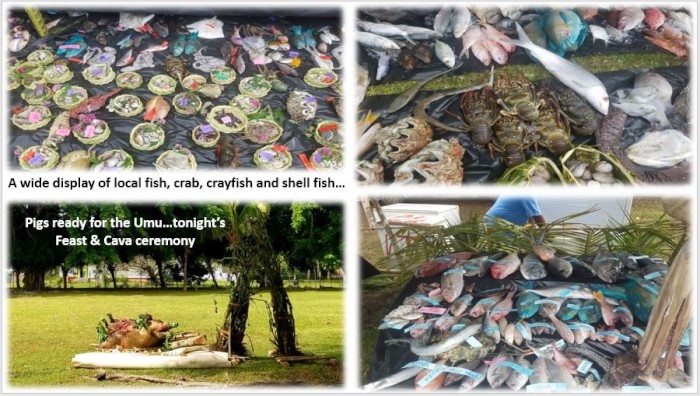
THE KING’S VISIT: A TIME OF SONG, DANCE, MUSICAL COMPETITIONS AND FESTIVAL PHOTOS
25 July 2019
Sharon Lockhart & Ian Steele
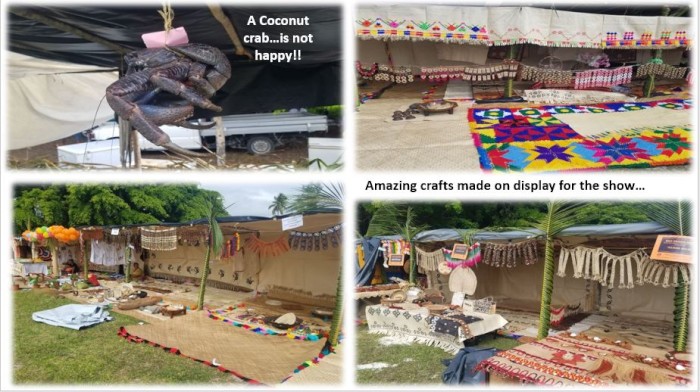
THE KING’S VISIT: A TIME OF SONG, DANCE, MUSICAL COMPETITIONS AND FESTIVAL PHOTOS
25 July 2019
Sharon Lockhart & Ian Steele
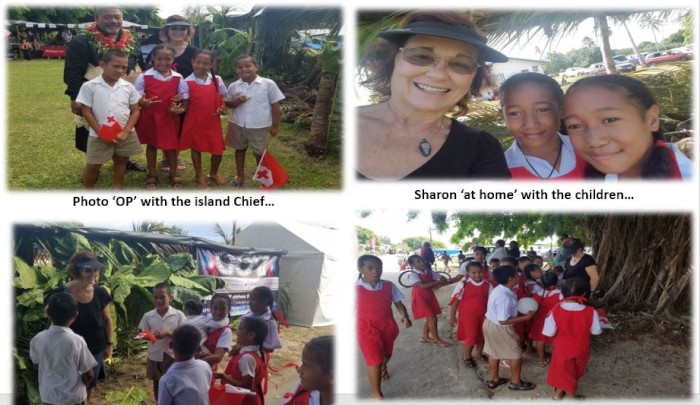
At home with the children...
THE KING’S VISIT: A TIME OF SONG, DANCE, MUSICAL COMPETITIONS AND FESTIVAL PHOTOS
25 July 2019
Sharon Lockhart & Ian Steele
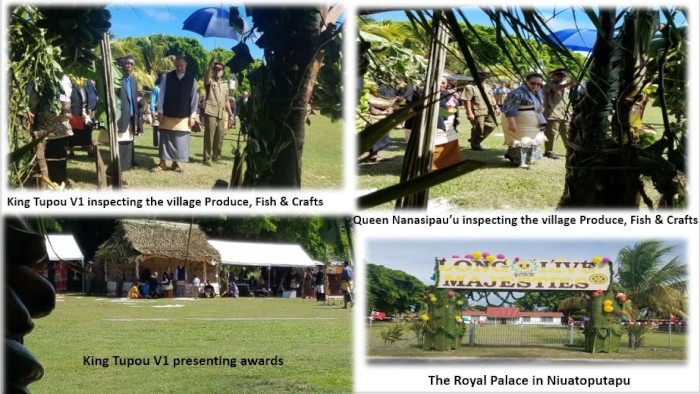
THE KING’S VISIT: A TIME OF SONG, DANCE, MUSICAL COMPETITIONS AND FESTIVAL PHOTOS
24 July 2019
Sharon Lockhart & Ian Steele
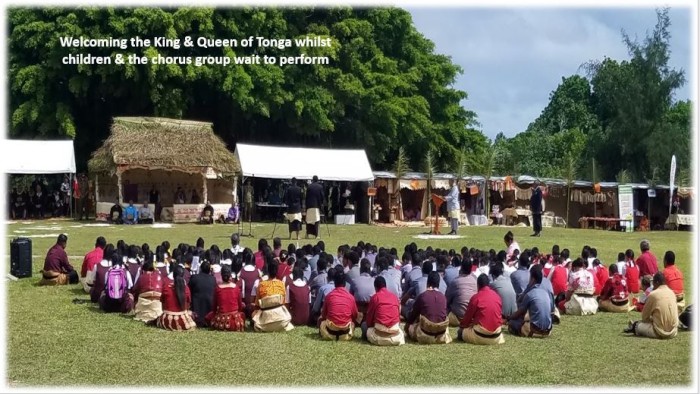
THE KING’S VISIT: A TIME OF SONG, DANCE, MUSICAL COMPETITIONS AND FESTIVAL
23 July 2019
Sharon Lockhart & Ian Steele
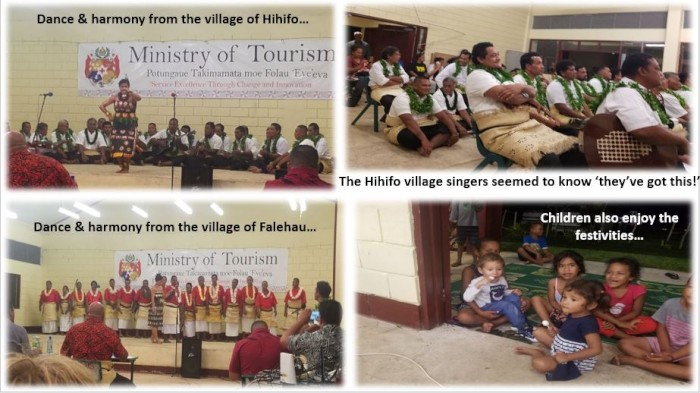
22-23 July 2019
The villages are busy at work, preparing the festival grounds with handmade entrance arches, greeting banners and palm- lined paths and booths to display agricultural products, handicrafts, and fishing catches intended to demonstrate the productivity and sustainability of this island to its King and Queen of Tonga who arrive on Wednesday.
On the evening before his arrival, there is a musical competition between the villages in which groups of men sit on the stage floor (in the school gymnasium) while singing and playing musical instruments, telling a story in song, while a beautifully-costumed woman stands before them acting out their story in the traditional hula-like dance form.
We “boaters” from the harbor are invited, and we set out walking at 7pm up the beach road toward the school. It is dark and traffic is “heavy” with cars filled with participants, however it is not long before we are picked up, tightly squeezed in and driven to the competition.
Inside the school, our group, again the only Caucasians in the audience, are seated on folding chairs in a place of honor near the front as many locals sit on the floor in back, often standing and dancing playfully to the music during intermissions, entertaining the spectators. A side treat was watching our little 2 ½ year old fellow boater interact with the local children sitting on the sidelines, exchanging toys, laughing and sitting on their laps- a lovely reminder of the innocence of children where language barriers and cultural boundaries do not exist- a powerful lesson for us adults the world over.
We watch as each village group performs a comparable routine while 3 official judges sitting in front grade their performance a la “America’s got Talent” style. The function is conducted in native Tongan, though the MC thoughtfully describes the process very briefly in English for our benefit. The performing group from Hihifo village includes Palavi, our police friend and his brother, the choir director, whose group eventually turns out to be the winner of the competition (deservedly so, in our opinion).
After a fun evening, we head out, walking along the now pitch- black road as full cars pass by headed home. After walking for a while, we are finally picked up in small groups and returned to the wharf, where we fumble back into our dinghies in the dark and return to our floating homes for a much-needed night of sleep.
The following morning, we 10 boaters again head out to the wharf, dock our dinghies together and start walking toward the festival grounds, but are quickly picked up by passing locals and dropped off at the festival grounds. We walk around and tour the many booths proudly displaying their bountiful catches from the sea, including large and small fish of every color and variety, along with many eels, octopi, shell fish, lobster and coconut crabs (see attached pics). The variety and color is astounding.
While we await the King’s arrival we mill around and talk to the school children who will soon perform for the King. They are very curious and hover around us, enjoying asking questions and having their pictures taken. They learn English at school, but their vocabulary is quite limited, so we exchange names and teach each other English and Tongan words for colors and various objects, with them laughing delightedly at my mispronunciations.
At last the King Tupou V1 and Queen Nanasipau’u arrive amid honor guards and proceed to their red velvet chairs on their makeshift palm-lined covered stage. The children gather in the grass and sit patiently in the bright sun, waiting through the long formal speeches until it is their turn to sing their choreographed performances.
The King presents various awards and commends the winners of the musical competition. After several more traditional dance performances, the King and Queen then walk around the entire perimeter, viewing the many display booths laden with agricultural products, the massive fish displays and beautiful woven mats and handiwork, reflecting the pride and productivity of this small island community.
After they depart, the products are offered for sale to the audience, and people rush up to buy fruits, vegetables and fish.
We boaties step up to purchase replacements for out dwindling boat supplies, but many of the locals refuse our money and insist that we take woven basketsful of bananas, papayas, peppers, melons and limes. We depart, laden with more than we can carry, eventually finding a ride back to the dock as we crawl up onto the back of an open-bedded utility truck filled with baskets of fish and locals also seeking a ride home—the ultimate island experience.
A fascinating day, another one-of-a-kind, lifelong island memory for our history books as we explore a lifestyle, light years away from modern western suburbia.
The villages are busy at work, preparing the festival grounds with handmade entrance arches, greeting banners and palm- lined paths and booths to display agricultural products, handicrafts, and fishing catches intended to demonstrate the productivity and sustainability of this island to its King and Queen of Tonga who arrive on Wednesday.
On the evening before his arrival, there is a musical competition between the villages in which groups of men sit on the stage floor (in the school gymnasium) while singing and playing musical instruments, telling a story in song, while a beautifully-costumed woman stands before them acting out their story in the traditional hula-like dance form.
We “boaters” from the harbor are invited, and we set out walking at 7pm up the beach road toward the school. It is dark and traffic is “heavy” with cars filled with participants, however it is not long before we are picked up, tightly squeezed in and driven to the competition.
Inside the school, our group, again the only Caucasians in the audience, are seated on folding chairs in a place of honor near the front as many locals sit on the floor in back, often standing and dancing playfully to the music during intermissions, entertaining the spectators. A side treat was watching our little 2 ½ year old fellow boater interact with the local children sitting on the sidelines, exchanging toys, laughing and sitting on their laps- a lovely reminder of the innocence of children where language barriers and cultural boundaries do not exist- a powerful lesson for us adults the world over.
We watch as each village group performs a comparable routine while 3 official judges sitting in front grade their performance a la “America’s got Talent” style. The function is conducted in native Tongan, though the MC thoughtfully describes the process very briefly in English for our benefit. The performing group from Hihifo village includes Palavi, our police friend and his brother, the choir director, whose group eventually turns out to be the winner of the competition (deservedly so, in our opinion).
After a fun evening, we head out, walking along the now pitch- black road as full cars pass by headed home. After walking for a while, we are finally picked up in small groups and returned to the wharf, where we fumble back into our dinghies in the dark and return to our floating homes for a much-needed night of sleep.
The following morning, we 10 boaters again head out to the wharf, dock our dinghies together and start walking toward the festival grounds, but are quickly picked up by passing locals and dropped off at the festival grounds. We walk around and tour the many booths proudly displaying their bountiful catches from the sea, including large and small fish of every color and variety, along with many eels, octopi, shell fish, lobster and coconut crabs (see attached pics). The variety and color is astounding.
While we await the King’s arrival we mill around and talk to the school children who will soon perform for the King. They are very curious and hover around us, enjoying asking questions and having their pictures taken. They learn English at school, but their vocabulary is quite limited, so we exchange names and teach each other English and Tongan words for colors and various objects, with them laughing delightedly at my mispronunciations.
At last the King Tupou V1 and Queen Nanasipau’u arrive amid honor guards and proceed to their red velvet chairs on their makeshift palm-lined covered stage. The children gather in the grass and sit patiently in the bright sun, waiting through the long formal speeches until it is their turn to sing their choreographed performances.
The King presents various awards and commends the winners of the musical competition. After several more traditional dance performances, the King and Queen then walk around the entire perimeter, viewing the many display booths laden with agricultural products, the massive fish displays and beautiful woven mats and handiwork, reflecting the pride and productivity of this small island community.
After they depart, the products are offered for sale to the audience, and people rush up to buy fruits, vegetables and fish.
We boaties step up to purchase replacements for out dwindling boat supplies, but many of the locals refuse our money and insist that we take woven basketsful of bananas, papayas, peppers, melons and limes. We depart, laden with more than we can carry, eventually finding a ride back to the dock as we crawl up onto the back of an open-bedded utility truck filled with baskets of fish and locals also seeking a ride home—the ultimate island experience.
A fascinating day, another one-of-a-kind, lifelong island memory for our history books as we explore a lifestyle, light years away from modern western suburbia.
SUPERB SACRED SUNDAY SINGING AND AN UMU FEAST
21 July 2019 | Niuatoputapu, Tonga
Sharon Lockhart & Ian Steele
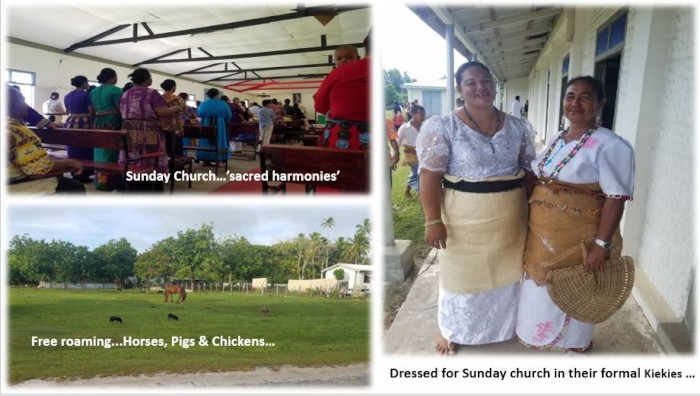
21 July 2019
On Friday morning a new sailing monohull northbound from Neiafu, Vava'u (our next Tongan port of call to the south) enters the narrow harbor passage and anchors near Wheytogo, reporting a calm passage. Later in the afternoon, three more sailboats appear at the entrance in close succession...yeah! Our friends from Apia have arrived without incident, other than low winds similar to what we experienced. We share some of our fruitful bounty along with info about securing customs clearance.
On Sunday morning all ten of us from three different sailboats (including one adorable and lively 2 yr old boy) head to the wharf on our dinghies, tie up on the precarious rocks, climb up to the road and begin walking en masse on the one-mile trip along the beach road to the local church. The air is warm and slightly muggy, though not nearly as stifling as in Samoa. Very shortly we are picked up by friendly locals who drive us there in groups. As we arrive to the packed church, beautiful choruses are already echoing out through the very simple open-air building. We slip into the back of the church and listen to the service spoken in the melodious vowel-driven Tongan language, punctuated frequently by the booming harmonious choruses for which the island people are so celebrated. The local people are dressed in their Sunday finery, including the Kiekies (decorative woven grass "aprons " with intricate shapes and colors worn by the women over their dresses) and Ta'ovalo ( woven mat-like "skirts" worn by the men around their hips over their pants and tied with rope) which are traditional garb worn in many ceremonies as a sign of respect. After the service where we were the only non-native people, we are greeted like dear friends by the locals including the doctor and customs officials we met at check-in and offered rides back to the wharf, which we gladly accepted.
At midday, Ian and I are picked up by Palavi the policeman and transported to his home in Hihifo village where we had been invited for a traditional Tongan Sunday dinner, an Umu feast. We arrive at the home of his brother, whom we learn was the director of the choir in the earlier church service. The 5 adults sit at the table, while the 6 children eat in another area. A lovely dinner is laid out on the table, including roast pig ( didn't we see the little guy last night running in the yard?), the traditional palasami (spinach-like taro leaves wrapped around either beef, pork or fish poached in coconut cream, then wrapped with banana leaves and cooked over the Umu pit), along with strips of fire-roasted tapioca root and breadfruit (having a texture similar to toasted bread) and sliced bananas marinated in coconut cream. For dessert we have fruit-flavored ice pops (a huge hit with the kids) and homemade banana pudding which I had made and was quickly devoured. The men quickly emptied the bottle of red wine Ian had brought.
After dinner, a major and unexpected treat: Palavi's brother, the choir director, pulled out his guitar and began to play and sing in his richly melodious voice, while the entire family, including the kids joined in for several songs, spontaneously dividing up the different harmonies among themselves.
The innate ability of these people to sing these amazing pitch-perfect harmonies never ceases to thrill and amaze us. Listening to their very unique musical style will remain one of my most treasured memories of the South Pacific islands.
On Friday morning a new sailing monohull northbound from Neiafu, Vava'u (our next Tongan port of call to the south) enters the narrow harbor passage and anchors near Wheytogo, reporting a calm passage. Later in the afternoon, three more sailboats appear at the entrance in close succession...yeah! Our friends from Apia have arrived without incident, other than low winds similar to what we experienced. We share some of our fruitful bounty along with info about securing customs clearance.
On Sunday morning all ten of us from three different sailboats (including one adorable and lively 2 yr old boy) head to the wharf on our dinghies, tie up on the precarious rocks, climb up to the road and begin walking en masse on the one-mile trip along the beach road to the local church. The air is warm and slightly muggy, though not nearly as stifling as in Samoa. Very shortly we are picked up by friendly locals who drive us there in groups. As we arrive to the packed church, beautiful choruses are already echoing out through the very simple open-air building. We slip into the back of the church and listen to the service spoken in the melodious vowel-driven Tongan language, punctuated frequently by the booming harmonious choruses for which the island people are so celebrated. The local people are dressed in their Sunday finery, including the Kiekies (decorative woven grass "aprons " with intricate shapes and colors worn by the women over their dresses) and Ta'ovalo ( woven mat-like "skirts" worn by the men around their hips over their pants and tied with rope) which are traditional garb worn in many ceremonies as a sign of respect. After the service where we were the only non-native people, we are greeted like dear friends by the locals including the doctor and customs officials we met at check-in and offered rides back to the wharf, which we gladly accepted.
At midday, Ian and I are picked up by Palavi the policeman and transported to his home in Hihifo village where we had been invited for a traditional Tongan Sunday dinner, an Umu feast. We arrive at the home of his brother, whom we learn was the director of the choir in the earlier church service. The 5 adults sit at the table, while the 6 children eat in another area. A lovely dinner is laid out on the table, including roast pig ( didn't we see the little guy last night running in the yard?), the traditional palasami (spinach-like taro leaves wrapped around either beef, pork or fish poached in coconut cream, then wrapped with banana leaves and cooked over the Umu pit), along with strips of fire-roasted tapioca root and breadfruit (having a texture similar to toasted bread) and sliced bananas marinated in coconut cream. For dessert we have fruit-flavored ice pops (a huge hit with the kids) and homemade banana pudding which I had made and was quickly devoured. The men quickly emptied the bottle of red wine Ian had brought.
After dinner, a major and unexpected treat: Palavi's brother, the choir director, pulled out his guitar and began to play and sing in his richly melodious voice, while the entire family, including the kids joined in for several songs, spontaneously dividing up the different harmonies among themselves.
The innate ability of these people to sing these amazing pitch-perfect harmonies never ceases to thrill and amaze us. Listening to their very unique musical style will remain one of my most treasured memories of the South Pacific islands.
MALO E LELEI (Hello in Tongan) To the island of Niuatoputapu Photos
20 July 2019 | Niuatoputapu, Tonga
Sharon Lockhart & Ian Steele
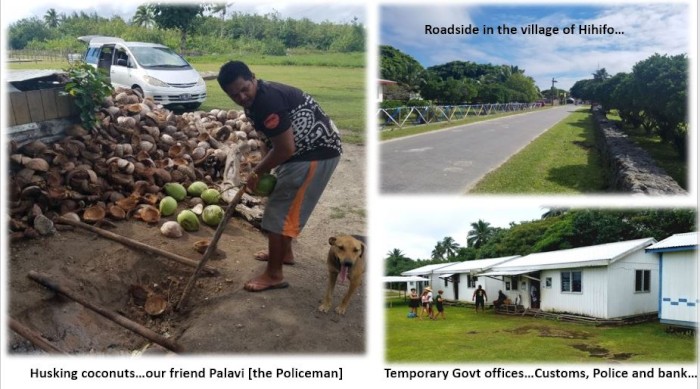
| Vessel Name: | Wheytogo |
| Vessel Make/Model: | Leopard 44 Catamaran |
| Hailing Port: | Austin Texas USA |
| Crew: | Ian Steele & Sharon Lockhart |
| Extra: | MMSI 367701140 WDI 4695 Contact email: wheytogo44@gmail.com |
Wheytogo's Photos - Summer Sailing to San Francisco
Photo 16 of 30 | Back To Album |
The watchkeeprs historical lookout post, Prisoners Cove, Santa Cruz Island
Added 13 March 2016
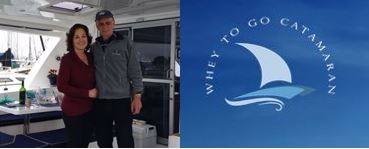
Who: Ian Steele & Sharon Lockhart
Port: Austin Texas USA
Current Position
Favorite Links
No Links Added Yet





